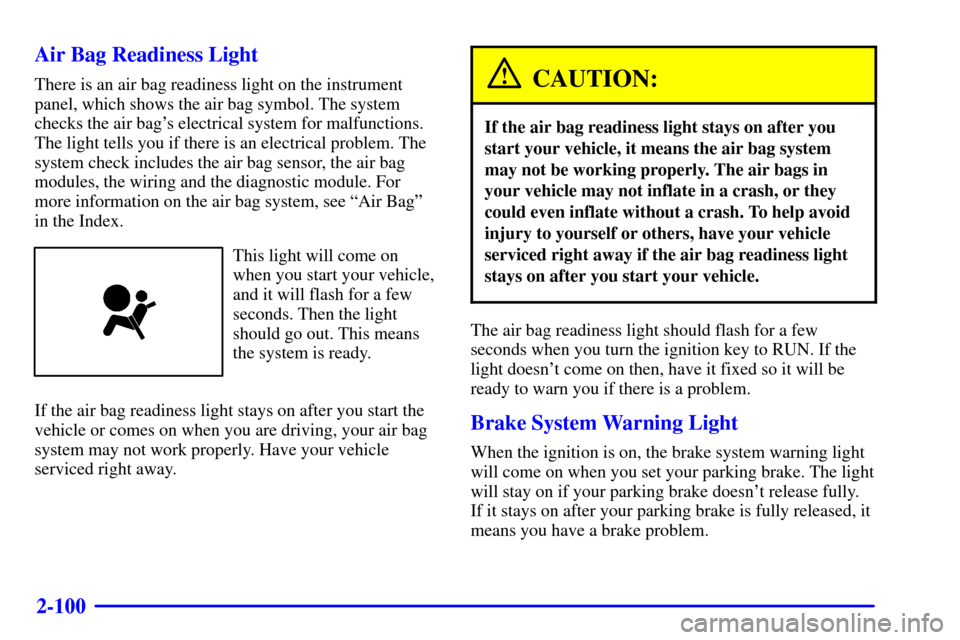Page 164 of 460
2-51
SECOND (2): This position gives you more power, but
lower fuel economy. You can use SECOND (2) on hills.
It can help control your speed as you go down steep
mountain roads, but then you would also want to use
your brakes off and on.
NOTICE:
Don't drive in SECOND (2) for more than 25 miles
(40 km), or at speeds over 55 mph (90 km/h), or
you can damage your transaxle. Use THIRD (3) or
AUTOMATIC OVERDRIVE (D) as much as
possible. Don't shift into SECOND (2) unless you
are going slower than 65 mph (105 km/h) or you
can damage your engine.
NOTICE:
If your vehicle seems to start up rather slowly, or
if it seems not to shift gears as you go faster,
something may be wrong with a transaxle system
sensor. If you drive very far that way, your
vehicle can be damaged. So, if this happens, have
your vehicle serviced right away. Until then, you
can use SECOND (2) when you are driving less
than 35 mph (55 km/h) and THIRD (3) for
higher speeds.
Page 180 of 460

2-67
A light sensor on top of the instrument panel makes the
DRL work, so be sure it isn't covered. The DRL system
will make front parking and turn signal lamps come on
in daylight when the following conditions are met:
�The ignition is on,
�the headlamp control is off, and
�the parking brake is released.
When the DRL are on, only your front parking and turn
signal lamps will be on. Your instrument panel won't be
lit up.
When it's dark enough outside, the exterior lamps will
come on automatically. When it's bright enough outside,
the exterior lamps will turn off and the DRL will turn
on. Of course, you may still turn on the headlamps any
time you need to.
To idle your vehicle with the DRL off, set the parking
brake while the ignition is in OFF or LOCK. Then start
the vehicle. The DRL will stay off until you release the
parking brake.
As with any vehicle, you should turn on the regular
headlamp system when you need it.Interior Lamps
Instrument Panel Intensity Control
Turn the thumbwheel, located below the headlamps
control, clockwise to increase the brightness of the
instrument panel lights, and counterclockwise to
decrease the brightness. Turn the thumbwheel all the
way counterclockwise to turn them off.
Interior Lamps Control
Turn the thumbwheel all the way clockwise to turn on
the interior lamps, if the interior lamps override switch
is off. Turn the thumbwheel counterclockwise to turn the
lamps off.
Page 213 of 460

2-100 Air Bag Readiness Light
There is an air bag readiness light on the instrument
panel, which shows the air bag symbol. The system
checks the air bag's electrical system for malfunctions.
The light tells you if there is an electrical problem. The
system check includes the air bag sensor, the air bag
modules, the wiring and the diagnostic module. For
more information on the air bag system, see ªAir Bagº
in the Index.
This light will come on
when you start your vehicle,
and it will flash for a few
seconds. Then the light
should go out. This means
the system is ready.
If the air bag readiness light stays on after you start the
vehicle or comes on when you are driving, your air bag
system may not work properly. Have your vehicle
serviced right away.
CAUTION:
If the air bag readiness light stays on after you
start your vehicle, it means the air bag system
may not be working properly. The air bags in
your vehicle may not inflate in a crash, or they
could even inflate without a crash. To help avoid
injury to yourself or others, have your vehicle
serviced right away if the air bag readiness light
stays on after you start your vehicle.
The air bag readiness light should flash for a few
seconds when you turn the ignition key to RUN. If the
light doesn't come on then, have it fixed so it will be
ready to warn you if there is a problem.
Brake System Warning Light
When the ignition is on, the brake system warning light
will come on when you set your parking brake. The light
will stay on if your parking brake doesn't release fully.
If it stays on after your parking brake is fully released, it
means you have a brake problem.
Page 233 of 460

2-120
When shifting into REVERSE (R) and an object is
detected, one of the following will occur:
A chime will sound the first time an object is detected,
if the object is between 20 inches (0.5 cm) and
5 feet (1.5 m) away.
Rear parking assist can detect objects 3 inches (7.6 cm)
and wider, and at least 10 inches (25.4 cm) tall, but it
cannot detect objects that are above liftgate level. In
order for the rear sensors to recognize an object, it must
be within operating range.If the rear parking assist system is not functioning
properly, the display will flash red, indicating that there is
a problem, unless the disable switch is on. The light
will also flash red when the vehicle is shifting into
REVERSE (R), if a trailer was attached to your vehicle, or
if a bicycle or an object was on the back of, or hanging out
of your liftgate during your last drive cycle. The light will
continue to flash whenever in REVERSE (R) until your
vehicle is driven forward at least 15 mph (25 km/h)
without any obstructions behind the vehicle.
It will also flash red if the ultrasonic sensors are not kept
clean. So be sure to keep your rear bumper free of mud,
dirt, snow, ice and slush or the system may not work
properly. If after cleaning the rear bumper and driving
forward at least 15 mph (25 km/h), the display continues
to flash red, see your dealer.
It may also flash red if your vehicle is moving in
REVERSE (R) at a speed greater than 3 mph (5 km/h).
Other conditions that may affect system performance
include things like the vibrations from a jackhammer or
the compression of air brakes on a very large truck.
As always, drivers should use care when backing up a
vehicle. Always look behind you, being sure to check for
other vehicles, obstructions and blind spots. For cleaning
instructions, see ªCleaning Your Vehicleº in the Index.
Page 415 of 460
6-64
Fuses Usage
20 Windshield Wiper/Washer Motor
and Switch
21 Turn Signal Switch
22 Rear Electric Accessory
Plug Housing
23 DRL Control Module
24 Not Used
25 Rear Window Defogger Relay,
Heated Mirrors
26 OnStar
�
27 Inflatable Restraint
Control Module
28 Heater
-A/C Control
29 Instrument Cluster, BCM,
Electronic Level Control (ELC)
Sensor and Relay
30 Stoplamp Switch
31 Module/Electronic Brake Control
Module/Electronic Brake Traction
Control Module (EBCM/EBTCM)Fuses Usage
32 Evaporative Emissions (EVAP)
Canister Vent Solenoid Valve
33 Not Used
34 ELC Air Compressor and ELC
Relay, Trailer Harness
35 Courtesy Lamp
36 BCM, Electronic Brake Control
Indicator Lamp Driver Module,
Instrument Panel Cluster, Rear
Side Door Actuator Control
Module, Rear Windows
37 Rear HVAC
-A/C Control
38 Rear Window Wiper Motor, Rear
Window Wiper/Washer and
Multifunction Switch (Rear
Window Wiper/Washer Switch)
39 Not Used
40 Not Used
41 Not Used
42 Not Used